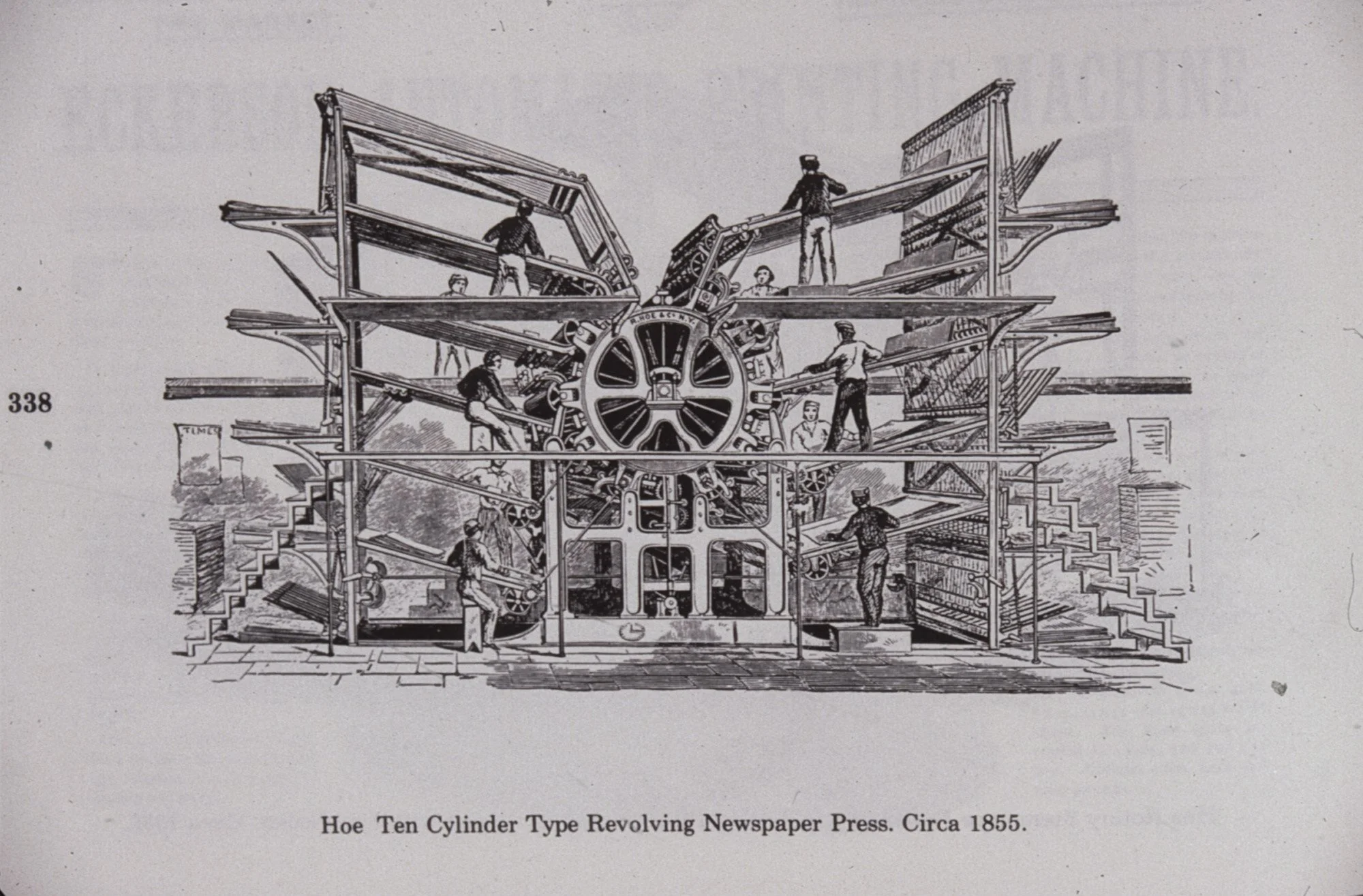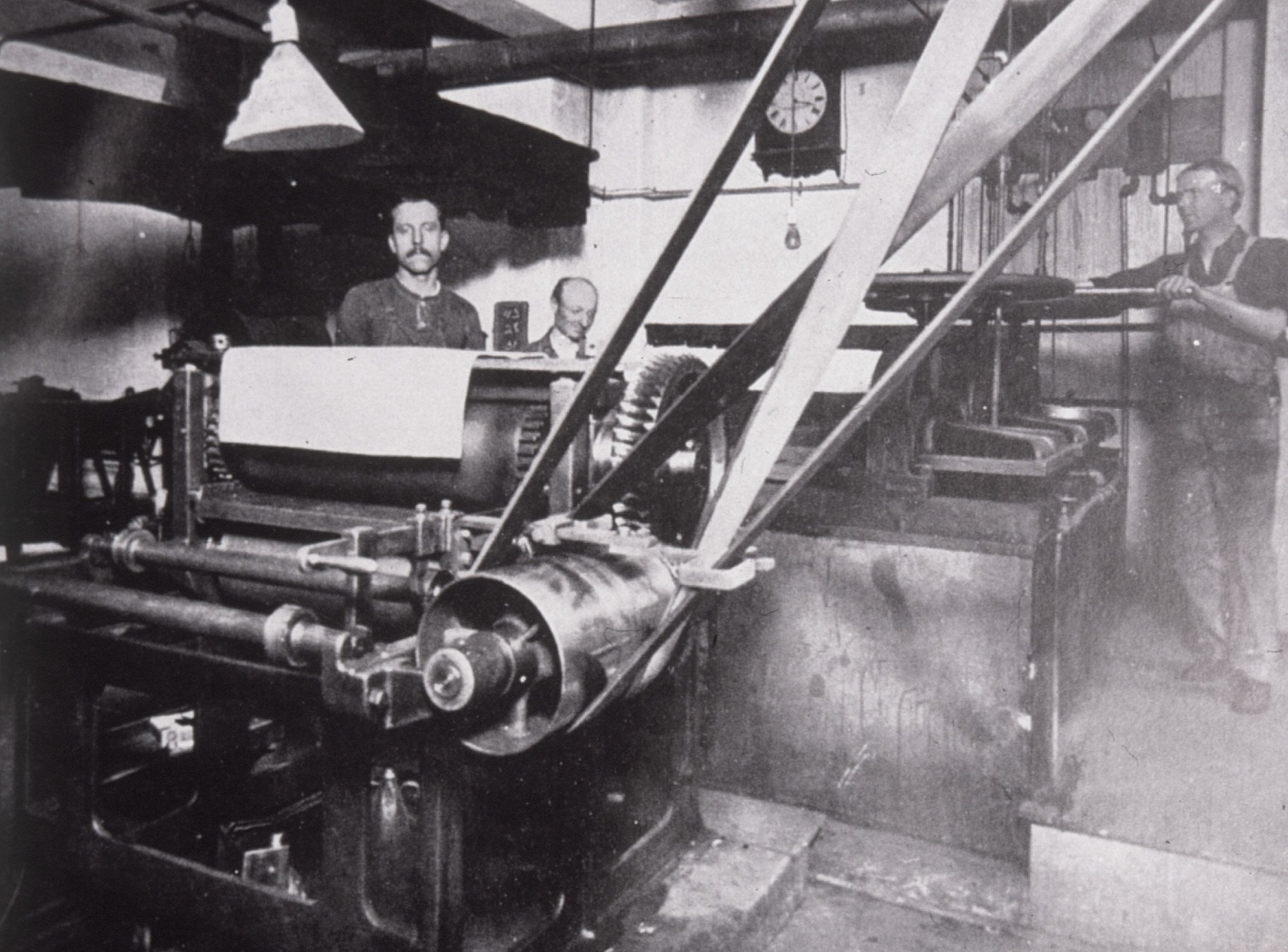Here is a varied look at some of the Printing Processes and the Machinery that made them possible. Many of these are still practised by folks like us!
Jeronimo and a “Printer’s Devil” (novice) at Folklife Festival, circa 1989. She is operating our Golding Official #3. Our theme for this show was “Printers Arrive in Seattle, 1860.” The good folks at The Longmire Cabin at Paradise, Washington on Mount Rainier loaned us their Covered Wagon for this event! We always invited the public to participate.
Some of the presses were IMMENSE! This press was capable of many thousands of impressions per hour.
WORK is what it took when this photo was taken! In a shop such as this, pretty much EVERYTHING was done by hand.
A typical method of powering this type of machinery. Usually a Steam-powered Engine would be employed to drive simple pulley systems that could be activated (and deactivated) by moving those belts on or off the Drive Pulley. Notice the “Hook” that holds the Pulley, as seen in the foreground. A drive system of shafts overhead ran throughout the shop. Electricity, as a method of powering machines, was not always available; but steam-power, long “perfected” usually was!
Apparently, knowledge of Gutenberg’s inventions (circa 1450) had not reached this gentleman. This is Old Technology!
Newsboys had a very difficult lifestyle! Today’s Labor Laws would never permit the harsh conditions (and sometimes treatment) they endured. This was a typical scene in nearly every major city in America.
Inside The Linotype Factory circa 1890. Once again, notice the overhead shafting and belting that power the Plant. This photo shows the improved “Star Based Machine” being fine tuned before delivery.
This Machine is the first iteration of a line-casting device that was COMPLETELY SUCCESSFUL. It was dubbed “The Blower” because the Matrices were assisted along their path through the Machine by blasts of air. The Machine’s inventor, Ottmar Mergenthaler, spent MANY years improving its MANY systems and indeed the next generation looked very different and did away completely with air-assisted Matrices. It was called “The Star Based Machine” as its footprint (Base) resembled a star, as shown in the Linotype Factory photo above.
A TRUE MECHANICAL GENIUS!
Here we are, back at Folklife Festival 1990. Kay is operating the first Press I ever owned! (THANKS FREDA & CLYDE!) It is an 8”x 12” Chandler & Price Treadle “Open Press” manufactured in 1911. It is in our Museum and runs like a DREAM. Come see for yourself!
This is the factory that manufactured the press that Kay is running in the photo above.
Here I am in the mid 1990’s (with mostly black hair!) operating the Model 14 Linotype at our original location in Belltown, Seattle. This was our shop: Orrin F. Drew Fine Printing, that was founded in 1906. We are the 3rd owners! See all of those sparkles on the floor? Those are lead shavings from the individual “slugs” (lines-o-type) as they are trimmed and shaved to an exact height of .918” (type high). I’m holding one slug (still very hot from casting at 540F) and you can see the tray is being filled as the lines are cast and ejected onto it. If you have seen one operate, you will understand why Thomas Edison dubbed the Linotype: “The 8th Wonder of The World!”
Here are those belts again! This time they are powering the Steel Matrix Department of The Mergenthaler Linotype Company. Hundreds of processes were necessary for the production of the Linotype. Ottmar invented a great number of them!
Master Printer Kay concentrates on QUALITY. Here she’s adjusting the height of the rollers so that they just “kiss” the metal types and deposit just the right amount of ink onto the paper. Maintaining tolerances is very important to quality and QUALITY is very important to Kay!
Anacortes: An early shot (bare walls!) showing our two Linotypes: the Model 14 (1920) in the foreground and the Model 29 (mid-1950’s) at the back. Lodged in between the two is the North American Post’s ORIGINAL press. It is a 10”x 15” Chandler & Price Open Press (1902) treadle machine (no motor). This is the press that we recently returned to its ORIGINAL owners in Seattle!
Thank You for visiting this page. We hope it will further spark your interest in The History of Printing and that you will contact us with any questions.














